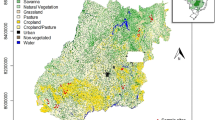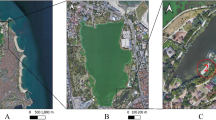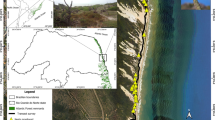Abstract
Although Tokyo daruma pond frogs (Pelophylax porosus porosus) were once commonly observed throughout paddy fields in Japan, their populations have recently declined. The mode by which frogs survive during the overwintering period is largely unknown. In this study, we observed the underground behavior of 12 free-living Tokyo daruma pond frogs that overwintered in paddy soil and a dry field by periodically excavating their overwintering positions from late March to early May. The mean overwintering depth of these frogs was ~ 19.8 cm, with 10 having migrated toward the soil surface (mean depth: ~ 8.6 cm) by late March, and finally, all 11 live frogs migrated further upward close to the soil surface. In addition, males tended to emerge earlier in spring than females. One monitored frog in the paddy soil that migrated close to the soil surface died, presumably from plowing. Aside from the 12 study frogs, several other mutilated frog corpses were found in the paddies. This species starts migrating to the soil surface during the same period when human disturbances begin, making the frogs vulnerable to these disturbances during this period. Consequently, it is necessary to facilitate the emergence of frogs to protect them from human disturbances—e.g., by temporarily filling fields with water.





Similar content being viewed by others
References
Azuma A, Takeuchi K (1999) Relationships between population density of frogs and environmental conditions in Yatsu-habitat. J Jpn Inst Landsc Arch 62:573–576. https://doi.org/10.5632/jila.62.573[inJapanese]
Biodiversity Center of Japan, Ministry of the Environment, Japan (2006) Revised red list reptile and amphibian: Available via online.https://ikilog.biodic.go.jp/Rdb/booklist of subordinate document. [in Japanese] Accessed 1 Oct 2019
Breckenridge WJ, Tester JR (1961) Growth, local movements and hibernation of the Manitoba toad, Bufo hemiophrys. Ecology 42:637–646. https://doi.org/10.2307/1933495
Doi T, Nozaki N, Yoshida M, Kanou C, Fukuda Y (2010) Observation hibernation of daruma pond frog, Rana porosa brevipoda reared in outdoor tanks. Hyogo Freshwater Biol 61(62):189–194 [in Japanese]
Duellman WE, Trueb L (eds) (1986) Biology of amphibians. McGraw-Hill, USA
Fujioka M, Lane SJ (1997) The impact of changing irrigation practices in rice field a frog population of the Kanto Plain, Central Japan. Ecol Res 12:101–108. https://doi.org/10.1007/BF02523615[inJapanese]
van Gelder JJ, Olders JHJ, Bosch JWG, Starmans PW (1986) Behavior and body temperature of hibernating common toads Bufo bufo. Holarctic Ecol 9:225–228. https://doi.org/10.1111/j.1600-0587.1986.tb01212.x
Holenweg AK, Reyer HU (2000) Hibernation behavior of Rana lessonae and R. esculenta in their natural habitat. Oecologia 123:41–47. https://doi.org/10.1007/s004420050987
Kusano T (2011) Ryouseirui no seitai kenkyuu ryouseirui no hanshoku idou wo rei to shite (Ecological study on amphibians using migration for breeding as an example). In: Matsui M (ed) The directions in batrachology. Shokabo Co Ltd, Japan, p 27
Liang TC (2013) Movements and habitat use of yosemite toads (Anaxyrus (formerly Bufo) canorus) in the Sierra national forest, California. J Herpetol 47:555–564. https://doi.org/10.1670/12-054
Mattoon A (2001) Deciphering amphibian declines. In: Brown LR, French FC, H, (eds) A Worldwatch Institute Report on Progress Toward a Sustainable Society. W W Norton & Co Inc, USA, pp 63–82
Mizuno A, Okubo K, Sawahata T (2007) Nagano-ken Ina-bonchi ni okeru daruma gaeru no tomin jokyo. Proceeding of the 54th year of the Ann Meet Ecol Soc Jpn, pp 2–235 [in Japanese]
Morita T, Kameyama T, Okada S (2001) Notes on hibernation of a Japanese pond frog, Rana porosa brevipoda. Bull Herpetol Soc Jpn 2001:46–47. https://doi.org/10.14880/hrghsj1999.2001.28[inJapanese]
Murakami H, Osawa S (2008) Effects of paddy rice cultivation type on the distribution of Rana nigromaculata and Fejervarya limnocharis. Jpn J Conserv Ecol 13:187–198. https://doi.org/10.18960/hozen.13.2_187[inJapanese]
Nakashima N, Moriyama T (2019) Developing the distribution model of Tokyo daruma pond frogs considering field's conditions. Proceeding of the 31th year of the Heisei period Conference of JSIDRE:788–789 [in Japanese]
Nakashima N, Noda K, Moriyama T, Mori A, Watabe K, Tamura T (2018) A case study of the conditions for crawling out by Tokyo Daruma pond frogs hibernating in the cultivated fields. JSIDRE 86:225–234. https://doi.org/10.11408/jsidre.86.I_225[inJapanese]
Niwa N, Aoyama S, Doi T, Ohbuchi M, Nomura K (1999) Kobe-shi ni okeru daruma gaeru no seisoku jokyo ni t suite. Hyogo Freshwater Biology 50:37–43 [in Japanese]
Noda K, Nakashima N, Moriyama T, Mori A, Watabe K, Tamura T (2019) Development of methods to detect hibernation sites of Tokyo Daruma pond frog (Pelophylax porosus porosus) using the PIT Tag system. Ecol Civ Eng 22:165–173. https://doi.org/10.3825/ece.22.165[inJapanese]
Osawa S, Katano J, Katsuno T (2003) Inhabitation of the Pond frog Rana porosa porosa in a ditch on the rural landscape of spreading paddy fields characterized by dispersed settlement. J Rural Plann Assoc 22:7–12. https://doi.org/10.2750/arp.22.22-suppl_7[inJapanese]
Osawa S, Kuroda T, Katsuno T (2006) The change of vegetation, fauna of frogs and mousse as small animals, on different management level in step-like paddy fields. J Jpn Inst Landsc Arch 69:565–570. https://doi.org/10.5632/jila.69.565[inJapanese]
Pilliod SD, Peterson CR, Ritson PI (2002) Seasonal migration of Columbia spotted frogs (Rana luteiventris) among complementary resources in a high mountain basin. Can J Zool 80:1849–1862. https://doi.org/10.1139/z02-175
Pyke G (2005) The use of PIT tags in capture-recapture studies of frogs: A filed evaluation. Herpetol Rev 36:281–285
Regosin JV, Windmiller BS, Michael RJ (2003) Terrestrial habitat use and winter densities of the Wood frog (Rana sylvatica). J Herpetol 37:390–394. https://doi.org/10.1670/0022-1511(2003)037[0390:THUAWD]2.0.CO;2
Serizawa T, Serizawa S (1990) Reproductive traits of the rana nigromaculata-porosa complex in japan III. sexual maturation and egg-laying of rana porosa porosa. Jpn J Herpetol 13:70–79. https://doi.org/10.5358/hsj1972.13.3_70[inJapanese]
Tada M, Ito K, Saito M, Mori Y, Fukumasu J, Nakata K (2019) Wintering site environment for the nagoya daruma pond frog (Pelophylax porosus brevipodus) in Kurashiki, Okayama Prefecture, Western Japan. JSIDRE 87:179–187. https://doi.org/10.11408/jsidre.87.I_179[inJapanse]
Tanaka K (2010) Nougyou ni yuuyou na seibutsu tayosei no shihyou Nourin suisan shou purojekuto kenkyuu no gaiyou (Indicators for biodiversity that are useful for agriculture: an overview of the research project of the ministry of agriculture forestry and fisheries). Shokubutsu Bou Eki Plant Protect 64:600–604 [in Japanese]
Tempaku M, Osawa S, Katsuno T (2012) The faunistic composition of frogs corresponding to the rice fields with various conditions in Noubi plains. J Jpn Inst Landsc Arch 75:415–418. https://doi.org/10.5632/jila.75.415[inJapanese]
Tattersall GJ, Ultsch GR (2008) Physiological ecology of aquatic overwintering in ranid frogs. Biol Rev 83:119–140. https://doi.org/10.1111/j.1469-185X.2008.00035.x
Watabe K (2014) Restriction of frog migration by constructing agricultural concrete channels and conservation of frog populations. Bull Natl Inst Rural Eng 53:63–104. https://doi.org/10.24514/00002260[inJapanese]
Yamamoto Y, Senga Y (2012) The distribution of the Tokyo Daruma pond frog, Rana porosa porosa, and its habitat status in paddy fields fragmented by urbanization. Jpn J Conserv Ecol 17:175–184. https://doi.org/10.18960/hozen.17.2_175[inJapanese]
Zweifel RG (1989) Calling by the frog, Rana sylvatica, outside the breeding season. J Herpetol 23:185–186. https://doi.org/10.2307/1564030
Acknowledgements
We are grateful to the farmers in the research areas, especially Mr. Choichi Ueno, for accommodating us throughout the study and to Masakazu Mizutani, Professor emeritus at the School of Agriculture, Utsunomiya University, for his valuable guidance during the manuscript preparation. We also thank the students at the School of Agriculture, Utsunomiya University, for their cooperation with this study. We would like to thank Editage (www.editage.com) for English language editing.
Author information
Authors and Affiliations
Contributions
Naohisa Nakashima designed the study, and wrote the initial draft of the manuscript. Takumi Moriyama contributed to the analyses, interpretation of data, and assisted in the preparation of the manuscript. All other authors contributed to the data collection, interpretation of data, and critically reviewed the manuscript. All authors read and approved the final version of the manuscript, and agree to be accountable for all aspects of the work.
Corresponding author
Ethics declarations
Conflicts of interest
The authors declare that they have no conflicts of interest.
Rights and permissions
About this article
Cite this article
Nakashima, N., Moriyama, T., Motegi, M. et al. Underground behavior of overwintering Tokyo daruma pond frogs in early spring. Paddy Water Environ 19, 127–135 (2021). https://doi.org/10.1007/s10333-020-00824-5
Received:
Revised:
Accepted:
Published:
Issue Date:
DOI: https://doi.org/10.1007/s10333-020-00824-5




